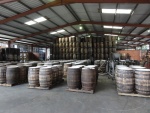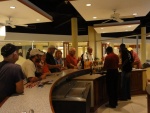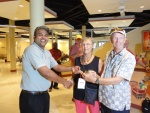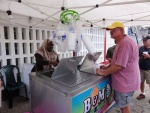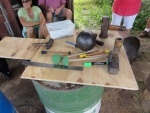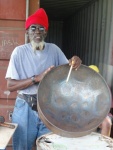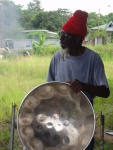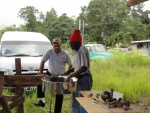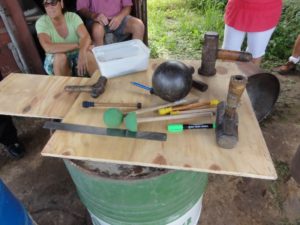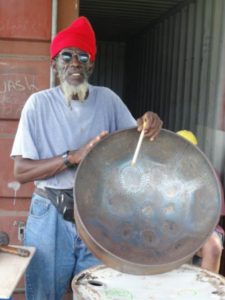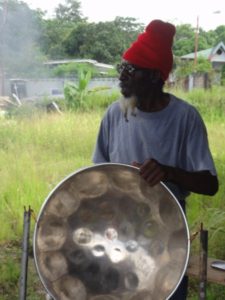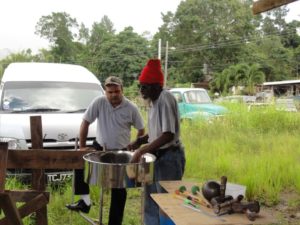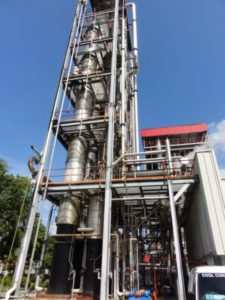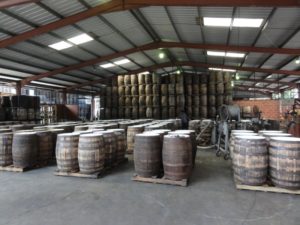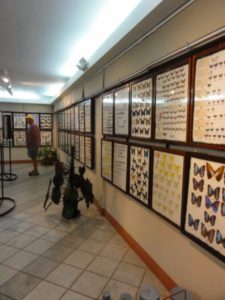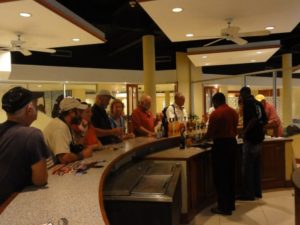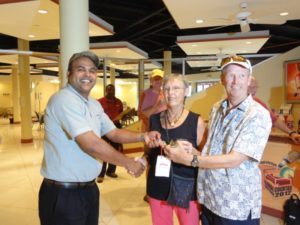Steel Pan & Bitters
by Bob & Janice Waller s/v Tsamaya
September 2012
When you think of Trinidad, 2 of the things that will most likely come to mind are steel pan music and Angostura aromatic bitters. So what better way to spend a day than learning the secrets (well some of the secrets) of these 2 truly Trinidadian things.
Our day started with Jesse picking us up and taking us to a steel pan factory. This factory consisted of a 4 posted pavilion about 10’x 10’ covered with corrugated tin connected to a shipping container.
Tony, the owner and operator of this pan factory, was very informative not only about the actually making of the pan, but the history of how the pan came to be. Between 1838 and 1883, the beating of skin drums was an integral part of Carnival celebrations. When a ban on all drum-beating was imposed in 1884 (Europeans were afraid the Africans slaves were communicating by drums) Carnival celebrants had to look for an alternative to the skin drum. They turned to bamboo after they discovered that dried bamboo of various diameters produced different sounds when cut to differing lengths and struck with wooden sticks. The steel pan developed in Trinidad with the arrival of the 55 gallon steel oil drum which is what they are still made from.
When asked how long it would take to make a pan Tony explained, if he was not interrupted with “liming” (that means socializing) it would take 4 days. Using a sledgehammer or a solid steel cannonball (about five or 6 inches in diameter) he pounds on the steel stretching it and as it stretches it creates a different pitch. The deeper the curve of the bottom of the drum, the thinner the steel, the higher the pitch. The cannonball is far more efficient and less tiring than the sledgehammer. The reason for this is that when striking the drum with the sledgehammer he uses only one hand but with the cannonball he literally bounces the 15 pound cannonball off the bottom with both hands.
When you look at the bottom of the steel drum the notes are arranged in a circular pattern with the lower pitch close to the rim and the higher pitch closer to the center. The various sized pans have a different sound and make up a different part of the band. In this way they have the bass, alto and the tenor pans.
Each player has a similar number of notes however as the notes get deeper in pitch they require more space in the pan. For this reason the tenor is able to contain all of the notes in one pan while the alto requires at least two pans and the base can require four or six steel drums. So although a steel pan looks like a drum it is definitely closer to a piano in its ability to play specific notes. In order to make it easier for people to learn how to play the pan as well as standardize the sound, the tuning of the pan is done with the piano. The placement of the notes is also standardized. Just as a person that plays a piano can sit down to any piano and start to play, the same can be done by a pan player due to this standardization of the instrument.
We also had a demonstration of the sound of the pan by a local Trinidadian. It is always amazing to hear the music that can be produced on these pans of steel.
After thanking Tony for his time we climbed back in the van and headed to the well-known producer of Angostura Bitters. When we entered we first went to their dining area to enjoy an excellent lunch arranged by Jesse. Our first introduction to their product was when we went to get our beverage of fruit juice. We all tried a dash of bitters in our juice which added “just a little extra” that was very pleasing.
We were handed over to a guide that showed us around the complex. This company not only produces Angostura bitters but they also produce a variety of rums and liqueur. First, we viewed an excellent video that gave the history of the production of the bitters as well as how they have expanded into many other areas such as the production of rum and combining with other distilleries. It is definitely a big business and the most modern we have seen on our travels.
The most important point to know about the production of the bitters is that currently only 5 people in the world know the recipe for making bitters. When a batch is ready to be made, one of these 5 people must come to the plant to complete the production of the bitters with their secret knowledge.
After leaving the bitters production area, we were driven around the area to see the bottling area (very modern), the assembling of the barrels and then to view their museum and a butterfly collection. The museum held many of the laboratory set-ups used in the production of the bitters during the by-gone years and told the history of the Siegert family.
The butterfly collection was a surprise; the person that collected all of these butterflies from the West Indies wanted to leave the country but was told by customs that he could not leave the country with the collection. Instead of having the collection broken up, he decided to sell the whole collection to Angostura so the public could continue to view them. It seems that Angostura is very aware of its responsibility to the community in which it lives and has several outreach programs supporting the community. This is seen in the local art work that covers the walls of the company’s public areas and the building of a community center for those that live in the area.
Once the touring was done, the tasting could start! Angostura sells rums from other distilleries thus there were quite a few to taste. They also offered various rum punch mixes and a coffee liqueur. The young man who served the samples was also extremely knowledgeable and helpful in explaining how you could use the different rums and the liqueurs. Quite a few of the cruisers (us included) helped the local economy by adding to our onboard inventory of spirits.
We thought the day was over, but remembering this was a Jesse James organized trip, we had to stop for ice cream on the way home. The “usual” vendor was not open; therefore we had to support a different street vendor. Homemade ice cream – Jesse definitely knows how to keep his customers happy!
If you ever come to Trinidad you most definitely need to hook up with Jesse James as he definitely knows how to put together a great trip no matter where you go!




